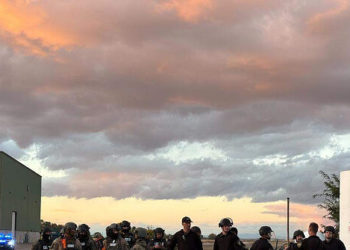Eighty years after the United States dropped the atomic bomb on Hiroshima, Japan, an alarming number of protracted crises are—or risk—pitting nuclear powers against each other. U.S. President Donald Trump’s recent announcement that he moved two nuclear submarines to “appropriate regions” in response to a social media message by former Russian President Dmitry Medvedev may not have resulted in a disastrous escalation. But it was a timely reminder that the “ultimate weapon” is an ever-present factor in today’s volatile security environment.
Today, nuclear-armed adversaries are on different sides of conflicts and standoffs, from Europe to the Himalayas to the Korean Peninsula. And that’s just for now. Israel and the United States severely dented Iran’s nuclear capabilities with military strikes last June, but Iran could attempt to rebuild its program and race for a bomb. At a time when arms control talks around the world are adrift, it is essential to lower tensions between nuclear powers and construct frameworks to manage frictions between them.
No two conflicts are identical. In Europe, Russia has repeatedly used nuclear threats as it tries to keep the United States and its NATO allies out of its war with Ukraine and to limit their support to Kyiv. In Asia, a terrorist attack in Kashmir last April sparked armed conflict between India and Pakistan, which many feared could spiral out of control. In both cases, there is a danger that future hostilities will be even more intense.
The logic of nuclear deterrence may still limit how far such crises will escalate. At the same time that it has used nuclear threats, Russia has avoided steps—such as strikes on supplies bound for Ukraine through NATO territory—that could lead to an all-out war with those countries. Similarly, while the recent India-Pakistan crisis heated up uncomfortably fast, South Asian officials insisted that both India and Pakistan know the rules of the game for keeping their on-again, off-again clashes below the nuclear level.
While that may be true, but there is no guarantee that, intentionally or unintentionally, nuclear powers will not cross each other’s red lines—and no certainty on what happens after a nuclear weapon is used.
Dangers of escalation are increasing in some regions. In Europe, NATO and Russia seem to be embarking on a conventional arms race. While it is necessary that European states—uncertain about the future of U.S. security commitments—bolster their defenses, this may also spur more Russian nuclear saber-rattling. In return for North Korea’s support against Ukraine, Russia has effectively ended its limited cooperation with the United States to rein in North Korea’s military ambitions. Russian technical support risks making North Korea an even more dangerous military opponent, while Russia has used its veto in the United Nations Security Council to block U.N. monitoring of nuclear-related sanctions.
The existing nonproliferation regime has historically done a good deal of work constraining the spread of nuclear weapons. But it is now fraying and clearly only of limited use in situations where major powers are pulling in different directions. As a result, it is crucial that concerned states—including the United States—take steps to minimize the risks of individual crises escalating to the nuclear level. This involves addressing not only nuclear weapons, but also the political frictions and conventional military tensions that could lead to adversaries inching toward nuclear use.
One immediate and relatively easy step is to improve communication between nuclear-armed states. This is a lesson left over from the Cold War, when the United States and the Soviet Union established emergency hotlines. As Russia’s war on Ukraine rages, the two countries maintain some channels to communicate with each other. This has enabled them to arrange prisoner exchanges and even engage in occasional direct negotiations. U.S. and Russian officials have also continued to communicate and meet. But formal military contact between NATO and Russia is nonexistent. In South Asia, senior military-to-military contact between India and Pakistan, though still active during the recent conflict, was hampered by mutual mistrust and the glaring absence of any high-level diplomatic channels of communication.
Having clear and reliable channels of communication set up in advance can help both sides signal their commitment to preventing escalation and rapidly defuse crises. In the case of India and Pakistan, for example, the two should supplement existing military-to-military channels of communication with hotlines linking their political leaders’ offices. Establishing a quiet back channel between the two countries’ national security advisors could also help defuse future tensions, especially when domestic political pressure makes standard diplomatic interactions difficult.
In the long term, it is necessary to reinforce global nonproliferation mechanisms. The International Atomic Energy Agency (IAEA) has played a significant role in reporting on Iran’s nuclear program, for example, but Iran increasingly views the agency as a tool for Western interference. It is important that influential powers from the global south speak in support of the IAEA’s apolitical mandate and the nonproliferation norm in order to bolster its continued credibility.
In 2022, when Russia appeared to be mulling a nuclear attack on Ukraine, G-20 leaders signed a communique coordinated by Indonesia that declared the “use or threat of use of nuclear weapons is inadmissible.” Major powers should reassert this point, especially in the run-up to a review conference on the Nuclear Non-Proliferation Treaty next year. Every state should aim to reinforce both the taboo against nuclear use and the unthinkability of breaking it.
The sooner that nuclear and non-nuclear powers start working on these preventive measures, the better. It is always better to put in place buffers against the risks of nuclear escalation early rather than to try and restore calm in the heat of a crisis. Managing the dangers of nuclear weapons will be vital to international crisis management for the foreseeable future.
If Aug. 6 marks 80 years since the first time an atomic bomb was used in war, then Aug. 9 marks another anniversary: 80 years since the last time an atomic bomb was used in war. By taking basic risk reduction measures right now, world leaders can ensure that this eight-decade success continues.
The post 80 Years After Hiroshima, Nuclear Risks Are Rising appeared first on Foreign Policy.




